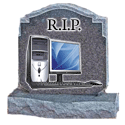THE SHAPE OF COMPUTING
Strewn across the floor and stacked in my closet are 100’s of lifeless parts. Processors, cords, connectors and fans, dead and lifeless now, they were once proud warriors of the desktop era. Striving to be faster in a technical world consumed by speed, I greeted new processors and motherboards like a lion greets wildebeasts. Today those dark ages are gone, replaced by a Renaissance of Mobility, or as the techies would say, “let me grab my portableâ€.
A continuous stream of processor advancements has boosted performance tremendously. Multi core processors were introduced by IBM some 7 years ago and since then, two and four core processors have become today’s norm. Like a landslide, they are coming from Intel and AMD. A recent trip to Best Buy resulted in finding not one computer with a single core processor. The selection of laptops was by far broader than the selection of desktops. My count today was Desktops 18 models and Laptops 55 models.
The advances in processors, memory, and now hard drives have left our local ISP as the main stumbling block to all things fast. If it’s not the choice of ISP or type of service, then it’s the malware gremlins conspiring to slow things down. Download caps, rogue applications and malware are the Godzilla, stopping instantaneous results at the moment of “CLICKâ€
Today’s modest laptop is likely faster than the desktop you were using 4 years ago. Yes, I’m aware there were some very fast computers available back then, but I’m talking in generalities here – a four-year-old HP desktop compared to today’s current HP laptop. Considering memory, multicore processing, and storage, today’s laptop is going to look mighty good sitting alongside your old desktop.
Two years ago I was all excited about the camera included in my cell phone. Hundreds of blogs were discussing the latest and greatest in mega pixels. Warnings about the need to be careful, lest you are caught in the act of being the real you, were everywhere. Now, it hardly gets mention in the advertising of phones or laptops. Of course the portable or phone has a camera, of course it’s got great resolution.
For the consumer, desktops came first, followed by luggables, laptops, ultra portables and phones. Today it doesn’t much matter if it’s labeled as an ultra light portable, a laptop or a cell phone. They have operating systems, emails, and keyboards. They can make, store, and play movies, pictures, and songs. You can use them for work or surf your favorite website. At your desk, on a plane, or even driving, you can do it all and do it now.
Take a look at this quote from Wikipedia, “A portable computer is a computer that is designed to be moved from one place to another. Portable computers, by their nature, are microcomputers. Early portables were unkindly referred to as “luggables,” referring to their great size and weight.†Portable computing was taking shape as early as 1976 with the Xerox NoteTaker. In its day, the luggable was as exciting as today’s Lenovo ThinkPad X200 or the Asus eee at 9 in. and .99 kg. I bet that in 3 years it will be as hard to find a desktop as it is to find a single core processor now. The term will be as outdated as the term Cassette or luggable. It will be just another name used to describe the shape of computing. Just like Mainframe, Time Share Computer Terminals, Alatar 880, Apple1, Personal Computers, Luggable, and Desktop replacements. The names given to the shape of computing could fill this page.
A couple of weeks ago, in the comments section of our latest SSD article, a reader named William Thomas pretty much summed it up.
“Good point about the need for operating systems to be on SSD. I believe laptops are converging with PDA’s and phones. The vogue for small laptops has returned. I suspect we will see operating systems supplied on chips, like bios- and the SSD is a chip.â€
So what are you really using today. Is it a phone, a laptop, or a desktop. Is today’s laptop tomorrow’s luggable? You bet it is, because what you’re using today is a computer, it’s better, it’s smaller and it does it all. Even more exciting than that, it does it from anywhere.





